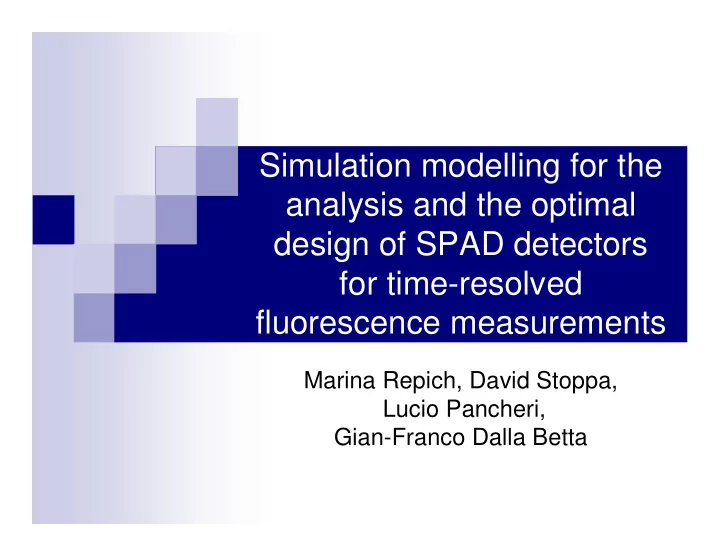

Simulation modelling for the analysis and the optimal design of SPAD detectors for time-resolved fluorescence measurements Marina Repich, David Stoppa, Lucio Pancheri, Gian-Franco Dalla Betta
Typical fluorescence measurement setup Excitation � The photodetector light determines the accuracy Fluorescent sample of the measurements. Emitted � General performance of Optical light Light measurement setup are system source defined by all part: from light source to software. Data processing Photo detector
System structure ������������� ����������� � The simulation model ������������� ����������� ����������� �������������� consists of a set of ����������� �������������� independent blocks each of ������������ ������������ ����� them simulates an ������������ ����� ������������ appropriate part of the ������������ ��������������� ������������ ��������������� experiment ����� ����� ����������� ����������� � Optimization algorithm ��������� ��������� provide an opportunity to fit ���������������� ���������������� SPAD and experimental setup parameters to ������" ������" achieve the optimal system ����������������� performance ����������������� ������!������ ������!������ ������������������� ��������� ������������������� ��������� ��������������� ���������������
Simulation workflow (�������%����� ����'���������� $����#��� ��#������ ����������#� &���������� ���'����##������ #������� )������������ ���������� ���� ������������� ������� �� ���� � � ���� ������������ ������ ���������� $��������#�������%� ��������������� &�������� � ��� � �� ���� ���� ���� ������� �#����������� $������������� ����������%��� ������������ �)& ��� Time in nanoseconds
Simulation workflow (�������%����� ����'���������� $����#��� ��#������ ����������#� &���������� ���'����##������ #������� )������������ ���������� ���� ������������� ������� �� ���� � � ���� ������������ ������ ���������� $��������#�������%� ��������������� Light spectrum &�������� � ��� � �� ���� ���� ���� Light pulse ������� �*+� Power �#����������� $������������� Power in con. un. ����������%��� ������������ FWHM Power �)& ��� Wavelenght in nm Time in nanoseconds 28.5 29 29.5 30 30.5 Time in ns
Simulation workflow (�������%����� ����'���������� Assumptions: $����#��� � ��#������ ����������#� &���������� ���'����##������ #������� )������������ ���������� ���� � the light absorption obeys the Beer- ������������� ������� �� ���� � � ���� ������������ Lambert law; ������ ���������� � fluorophores have $��������#�������%� uniform distribution; ��������������� the optical density of � * ( ln ���� ) t t z = + − τ &�������� the fluorescent � ��� � �� ���� ���� sample is negligible; ������� � fluorescence decay is monoexponential; � * �#����������� $������������� there are no other Power in con. un. � Power processes ����������%��� ������������ influencing light �)& ��� emission except fluorescence. 540 590 640 Time in nanoseconds Wavelength in nm
Simulation workflow (�������%����� ����'���������� Filter transfer function $����#��� Fluorescence spectrum ��#������ ����������#� &���������� ���'����##������ #������� 1 )������������ ���������� ���� 0.8 ������������� ������� �� ���� � � Probability ���� ������������ 0.6 Power ������ ���������� 0.4 $��������#�������%� 0.2 ��������������� 0 &�������� � ��� � �� 540 590 640 540 560 580 600 620 640 ���� ���� ���� Wavelength in nm Wavelength ������� �#����������� $������������� Power in con. un. Power ����������%��� ������������ �)& ��� Time in nanoseconds 540 560 580 600 620 640 Wavelength in nm
Simulation workflow Afterpulsing probability density (�������%����� 100000 ����'���������� Photon detection probability $����#��� ��#������ ����������#� &���������� ���'����##������ #������� 35 )������������ ���������� ���� 30 10000 DCR 25 ������������� ������� �� ���� � � P ro b a b ility 4kHz ���� ������������ 20 Dead time ������ ���������� 15 1000 0 500 1000 1500 2000 2500 3000 3500 4000 4500 5000 10 $��������#�������%� Time in ns 5 ��������������� 0 &�������� � ��� � �� 350 450 550 650 750 850 950 1050 ���� ���� ���� Wavelength in nm ������� Time response 100000 �#����������� $������������� Power in con. un. 10000 Event counts ����������%��� ������������ 1000 �)& ��� 100 10 1 Time in nanoseconds 1 1.5 2 2.5 3 3.5 4 Time in ns
Simulation workflow (�������%����� ����'���������� $����#��� ��#������ ����������#� &���������� ���'����##������ #������� )������������ ���������� ���� ������������� ������� �� ���� � � ���� ������������ ������ ���������� $��������#�������%� ��������������� &�������� � ��� � �� ���� ���� ���� ������� 100000 10000 �#����������� $������������� Power in con. un. Power in con. un. 1000 ����������%��� ������������ �)& ��� 100 10 1 Time in nanoseconds 0 10 20 30 40 50 Time in ns
Recommend
More recommend